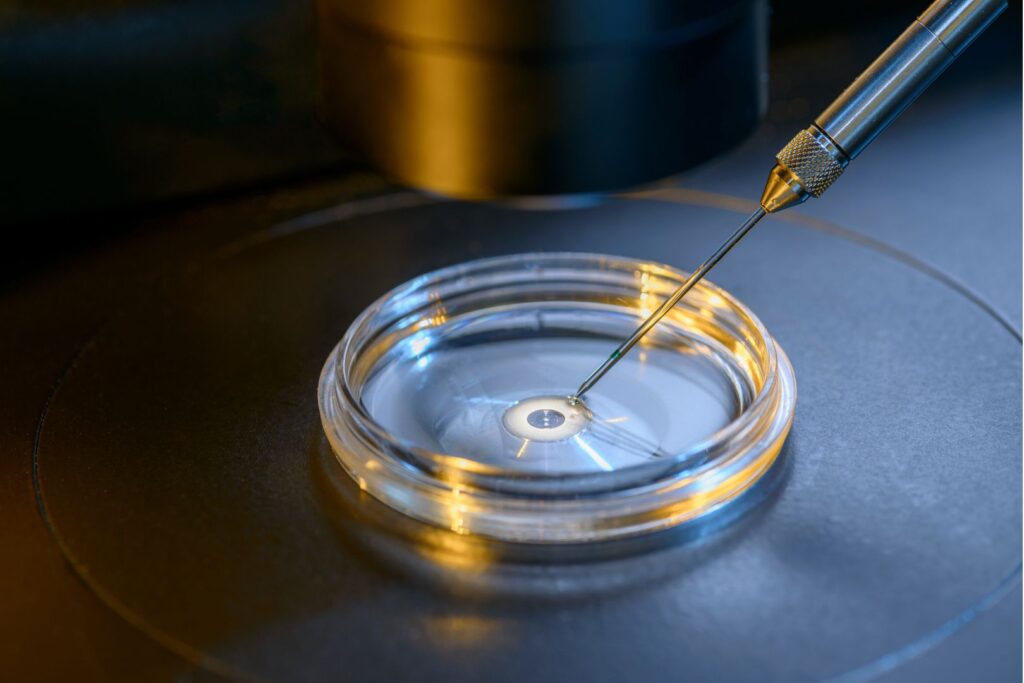When it comes to growing your family, there’s no one-size-fits-all path, and that’s why it can often feel so overwhelming. Between IVF, IUI, fertility preservation, and donor options, to the very real choice of pausing or stopping treatment, it’s easy to get lost in a sea of “what ifs”. Add the pressure of cost, time, and emotional toll, and it’s no wonder many people feel paralyzed by the decision.
So let’s take a step back.
At Reproductive Fertility Center (RFC), we believe that every journey is unique and valid. Whether you’re considering your first IUI, navigating donor conception, or going through an IVF cycle, your experience matters. And we’re here to help you make informed, empowered decisions that feel right for you.
Table of Contents
First, What Are Your Options?
IUI (Intrauterine Insemination)

Intrauterine insemination is a non-surgical fertility treatment where washed sperm is placed directly into the uterus around the time of ovulation, bypassing the cervix and reducing the distance sperm would have to travel to reach the egg. It’s often used to in cases of mild male factor infertility, ovulation disorders, or when using donor sperm.
IVF (In Vitro Fertilization)

In vitro fertilization is an advanced fertility treatment where eggs are retrieved from the ovaries and fertilized with sperm in a laboratory to create embryos that are then transferred back into the uterus. IVF is used to bypass certain fertility challenges and increases the chances of a successful pregnancy.
There are a few different types of IVF available. It is important to choose what is best for you and your fertility journey.
Natural IVF
What is natural cycle IVF? Natural cycle IVF is a type of fertility treatment that follows the body’s natural cycle. Instead of using fertility medications to stimulate the ovaries, this method works with an individual’s menstrual cycle to retrieve the single egg the body produces on its own. That one egg is then fertilized with sperm in a lab to create an embryo and is then transferred into the uterus.
Because there are no (or very minimal) medications used, this approach is less physically intense and can be ideal for people who cannot or do not wish to take fertility drugs. However, since only one egg is retrieved, mini stim IVF success rates are lower and often require multiple cycles to achieve a pregnancy.
Mini Stim IVF
What is mini stim IVF? Mini Stim IVF is a “gentler” version of conventional IVF. It uses lower doses of fertility medications to stimulate the ovaries to produce a small number of eggs. The goal of mini stim IVF is to retrieve a few high-quality eggs instead of aiming for a large quantity. Other than the lower doses of fertility medications, the process is similar to conventional IVF.
This method can be less costly and easier on the body, but like natural IVF, it may require multiple cycles to match the success rates of conventional IVF.
Conventional IVF
Conventional IVF is the most widely used and well-studied method. Fertility medications are used to stimulate the ovaries to produce multiple eggs at a time. The eggs are retrieved, fertilized in a lab, and then carefully monitored as they develop into embryos.
With this method, patients can freeze extra embryos, undergo PGT (preimplantation genetic testing), and choose the best-quality embryos for transfer. While the upfront cost and medication load are higher, conventional IVF often results in better success rates per cycle and may reduce the need for repeated treatment.
Donor IVF
Donor IVF is a variation of the conventional IVF process where donor eggs, donor sperm, or donor embryos are used. The embryos created, or donor embryos, are then transferred into the intended parent’s uterus or into a gestational carrier, depending on the circumstances.
Donor IVF is often recommended for people with poor egg or sperm quality, premature ovarian failure, or genetic conditions that the intended parents don’t want to pass on. It’s also a wonderful option for LGBTQIA+ couples, single parents by choice, and anyone who wants to grow their family in a different but deeply meaningful way.
Fertility Preservation (Egg or Embryo Freezing)

Fertility Preservation is the process of safeguarding your reproductive well-being by freezing your eggs, sperm, or embryos, also known as cryopreservation, with the purpose of using them later on.
Fertility preservation is ideal for individuals delaying parenthood until they feel more ready or undergoing medical treatments like chemotherapy, which can affect reproductive health.
Donor Conception

Donor conception involves using donor sperm, donor eggs, or donor embryos to achieve pregnancy through IVF. It’s a great option when one or both partners can’t use their own reproductive material due to age, medical conditions, or genetics. It’s also commonly chosen by LGBTQIA+ couples and single parents by choice.
Surrogacy (Gestational Carrier)

Surrogacy is when another person, a gestational carrier, carries a pregnancy for the intended parent(s), using either the intended parents’ embryo or donor-created embryos. The gestational carrier has no genetic connection to the baby. It’s often chosen when pregnancy isn’t safe or possible.
Choosing to Pause or Stop Treatment
Some individuals or couples decide to pause or stop fertility treatment temporarily or permanently. It’s a deeply personal decision that often comes with complex emotions and deserves just as much support and respect as any other path.
The Different Types of IVF: Side-by-Side Comparison
If you’re thinking of going the IVF route, it may feel overwhelming given that there are a few different types to choose from, especially when you’re weighing things like cost, medications, and success rates. To help simplify the decision-making process, we’ve laid out a side-by-side comparison of the IVF options. This quick overview can give you a clearer sense of what each path involves and who it may be best suited for.
|
Type of IVF
|
Medication
|
Cost
|
# of Eggs (Avg.)
|
Success Rate
|
Best For
|
|---|---|---|---|---|---|
|
Natural IVF
|
None/Low Dose |
$
|
~1
|
Low
|
Patients avoiding medication |
|
Mini Stim IVF
|
Low Dose
|
$$
|
3-7
|
Moderate
|
Older patients; cost-conscious patients |
|
Conventional IVF
|
High Dose
|
$$$
|
Varies
|
High
|
Ideal for most patients; PGT; freezing |
|
Donor IVF
|
Varies
|
$$$$
|
Varies
|
Very High
|
Patients with poor egg quality; over 40; LGBTQIA+ |
Is IUI Worth It?
IUI, or intrauterine insemination, can be a great first step for people who want a less invasive or lower-cost option. It’s often recommended for:
- People with mild male factor infertility
- Couples with unexplained infertility
- Single parents by choice
- LGBTQIA+ couples using donor sperm
While the success rate per cycle is lower than IVF, it’s a great starting point for many, especially if age and egg quality are not major concerns.
In Vitro Fertilization vs. Intrauterine Isemination
While both IUI and IVF are effective fertility treatments, they differ significantly in process, cost, and success rates.
IUI is a less invasive procedure, making it more affordable and often easier both physically and emotionally. This makes it a common first step for individuals facing mild male factor infertility, unexplained infertility, or those using donor sperm, such as single parents by choice or LGBTQIA+ couples.
IVF, on the other hand, involves higher upfront costs and more medications, but it also offers much higher success rates per cycle. IVF also allows for advanced options like embryo freezing and preimplantation genetic testing (PGT), which can be helpful for people with age-related fertility concerns, genetic conditions, or a history of unsuccessful IUI attempts.
In short, IUI can be a great starting point, especially when there are no major fertility barriers. IVF is often the next step, or even the first choice for many, when more control, higher success rates, or additional testing is desired.
How RFC Approaches IVF
At Reproductive Fertility Center (RFC), we recognize that every fertility journey is unique, and we’re proud to offer a range of options to meet individual needs. However, in most cases, our specialists recommend conventional IVF.
Conventional IVF is the most well-studied and widely used method in the field, offering the highest success rates per cycle. It allows us to retrieve multiple eggs, which means more embryos to work with and, in many cases, multiple chances of a successful pregnancy from a single cycle. This is especially helpful for patients who want the option to freeze embryos for future use or who wish to do preimplantation genetic testing (PGT) to select the healthiest embryos for transfer.

What sets RFC apart is the advanced technology we use to support your care. Tools like the EmbryoScope+ allow us to monitor embryo development without disruption, helping us select the strongest and healthiest embryos. We also use RI Witness, a tracking system that safeguards every sample and prevents mix-ups. These innovations help improve success rates, safety, and peace of mind.
While other types of IVF, such as natural IVF or mini stim IVF, can be appropriate in certain cases, conventional IVF often ends up being more time and cost-efficient in the long run. Patients benefit from fewer cycles, more control over embryo selection, and a greater sense of momentum on what can often be an emotionally demanding path.
Which Fertility Treatment is Right For You?
Choosing a fertility treatment path isn’t easy. There’s research, there’s cost, and there’s emotional weight to consider when making a decision.
Our role at RFC is to offer clarity, compassion, and real guidance so that whatever you choose, you don’t feel like you’re walking alone. Whether you’re ready to start a cycle, curious about options, or taking a breather, we are here to help you navigate this complex journey.




